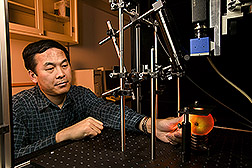
In fact, as I understand it, in many companies Testing is the department that imposes discipline on Development--which shouldn't be. SW Development Engineers have a set of steps that they go through when developing an application/component/whatever, which is different than the steps that SW Test Engineers go through--but each have their purposes. It is
not Test's job to ensure that SW Development Engineers have gone through their steps properly; it is however, Test's job to ensure that the product of Development's efforts is something suitable for what it was intended for.
Next, SW Test Engineers--please please
pleeeeeeaaassseee take some accountability for your job title!! Check out wikipedia's entry for
Engineering:
Engineering is the discipline and profession of applying scientific knowledge and utilizing natural laws and physical resources in order to design and implement materials, structures, machines, devices, systems, and processes that realize a desired objective and meet specified criteria. More precisely, engineering can be defined as “the creative application of scientific principles to design or develop structures, machines, apparatus, or manufacturing processes, or works utilizing them singly or in combination; or to construct or operate the same with full cognizance of their design; or to forecast their behavior under specific operating conditions; all as respects an intended function, economics of operation and safety to life and property.”
Engineering - Wikipedia, the free encyclopedia
...and notice the word "discipline". Development Engineers can (and should be) hounded for bad formatting and not commenting their code--along those same lines of being disciplined, let the rest of us know what you're trying to accomplish when writing your tests! Be explicit about what you're trying to test for, show steps for how to test for that, and be concise about what to expect. Just as a screwy, uncommented piece of code that someone else wrote can drive a Development Engineer nuts, a screwy test can have the same effect on your fellow Test Engineers. Please, learn to be disciplined in your work--you'll gain respect from your co-workers and probably realize that you missed a few things along the way. It's not hard--it just takes discipline!
 In fact, as I understand it, in many companies Testing is the department that imposes discipline on Development--which shouldn't be. SW Development Engineers have a set of steps that they go through when developing an application/component/whatever, which is different than the steps that SW Test Engineers go through--but each have their purposes. It is not Test's job to ensure that SW Development Engineers have gone through their steps properly; it is however, Test's job to ensure that the product of Development's efforts is something suitable for what it was intended for.
Next, SW Test Engineers--please please pleeeeeeaaassseee take some accountability for your job title!! Check out wikipedia's entry for Engineering:
In fact, as I understand it, in many companies Testing is the department that imposes discipline on Development--which shouldn't be. SW Development Engineers have a set of steps that they go through when developing an application/component/whatever, which is different than the steps that SW Test Engineers go through--but each have their purposes. It is not Test's job to ensure that SW Development Engineers have gone through their steps properly; it is however, Test's job to ensure that the product of Development's efforts is something suitable for what it was intended for.
Next, SW Test Engineers--please please pleeeeeeaaassseee take some accountability for your job title!! Check out wikipedia's entry for Engineering:
 I ran across this link while looking for a specific page in my del.icio.us test links, and while the products that this document is geared towards are a little different than what I deal with on a daily basis, the concepts are great. I particularly liked this section--especially the first sentence here--in the Verification & Validation section:
I ran across this link while looking for a specific page in my del.icio.us test links, and while the products that this document is geared towards are a little different than what I deal with on a daily basis, the concepts are great. I particularly liked this section--especially the first sentence here--in the Verification & Validation section:
 I love how Vista just decides to reboot and apply some updates while I'm in the middle of writing an email. No warnings, nothing. Just shuts down as if I said "Shutdown and kill all my apps in the process"... Nicely done M$. I love it when my OS gives me the finger.
I love how Vista just decides to reboot and apply some updates while I'm in the middle of writing an email. No warnings, nothing. Just shuts down as if I said "Shutdown and kill all my apps in the process"... Nicely done M$. I love it when my OS gives me the finger.
 A friend & coworker of mine sent me a link to
A friend & coworker of mine sent me a link to 